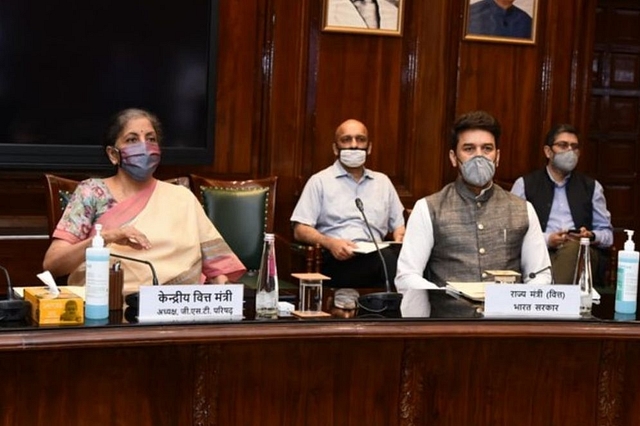
GST Shortfall: 20 States Including Maharashtra Get Nod To Borrow Rs 68,825 crore Via OMO, Comrade Issac Threatens To Go To Court
The Union government on Tuesday (Oct 13) permitted 20 states to borrow an additional Rs 68,825 crore through open market operations to make up for the Goods and Services Tax (GST).compensation shortfall this year.
Additional borrowing permission has been granted @ 0.50 percentage point of the Gross State Domestic Product (GSDP) to those States who have opted for Option- 1 out of the two options suggested by the Union Ministry of Finance to meet the shortfall arising out of GST implementation.
Out of the total Rs 68,825 crore, Andhra Pradesh has been allowed to borrow Rs 5,051 crore, Arunachal Pradesh Rs 143 crore, Assam Rs 1,869 crore, Bihar Rs 3,231 crore, Goa Rs 446 crore, Gujarat Rs 8,704 crore, Haryana Rs 4,293 crore, Himachal Pradesh Rs 877 crore, Karnataka Rs 9,018 crore, Madhya Pradesh Rs 4,746 crore, Maharashtra Rs 15,394 crore, Manipur Rs 151 crore, Meghalaya Rs 194 crore, Mizoram Rs 132 crore, Nagaland Rs 157 crore, Odisha Rs 2,858 crore, Sikkim Rs 156 crore, Tripura Rs 297 crore, Uttar Pradesh Rs 9,703 crore, and Uttarakhand Rs 1,405 crore.
In the meeting of GST Council held on 27th August, 2020, two options were put forward and were subsequently communicated to the States.
Under the Option 1, states could borrow Rs 1,10,000 crore (estimated loss in revenue attributable to GST implementation) from the Reserve Bank of India (RBI) at a concessional rate to be negotiated by the Centre. The increased borrowing by the states would be over and above any other borrowing ceilings. Further, the principal and interest would be paid using the compensation cess to ensure that no added burden on the states.
Under the Option 2, states could borrow the entire loss amount (attributable to GST, Covid-19 and any other factor) of Rs 2,35,000 crore from the RBI. However, this borrowing would be included in the borrowing ceilings set for the states and states would have to pay the interest from their own finances. The compensation cess would only pay the principal of the loan.
Twenty States have given their preferences for Option-1 . These States are - Andhra Pradesh, Arunachal Pradesh, Assam, Bihar, Goa, Gujarat, Haryana, Himachal Pradesh, Karnataka, Madhya Pradesh, Maharashtra, Manipur, Meghalaya, Mizoram, Nagaland, Odisha, Sikkim, Tripura, Uttar Pradesh and Uttarakhand . Eight States are yet to exercise an option.
Under Option-1, a special borrowing window will be coordinated by the Ministry of Finance to borrow the amount of shortfall in revenue through issue of debt. The total shortfall in the revenue of the States on this account has been estimated at around Rs 1.1 lakh crore. The permission to borrow the final instalment of 0.5% of GSDP out of the 2% additional borrowings permitted by the Government of India in view of the COVID pandemic, waiving the reforms condition.
In May this year, Union Finance minister Nirmala Sitharaman raised the net borrowing limit for state governments from 3% of the gross state domestic product (GSDP) to 5% ensuring an additional availability of Rs 4.28 lakh crore to all the states combined.
While 0.50 percentage point of the extra borrowing window was be available to all states unconditionally, one percentage point made available in four equal tranches with each linked to states accomplishing reforms in three out of the four identified areas - universalisation of ‘One Nation One Ration card’, ease of doing business, power distribution and augmentation of urban local body revenues.
Kerala and few other Congress-ruled States are reportedly planning to approach the Supreme Court against Centre’s decision to allow States to borrow up to ₹1.1 lakh crore from a special window facilitated by the Reserve Bank of India as mooted by Centre.